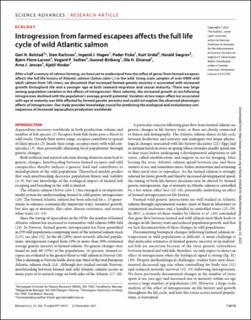| dc.contributor.author | Bolstad, Geir Hysing | |
| dc.contributor.author | Karlsson, Sten | |
| dc.contributor.author | Hagen, Ingerid Julie | |
| dc.contributor.author | Fiske, Peder | |
| dc.contributor.author | Urdal, Kurt | |
| dc.contributor.author | Sægrov, Harald | |
| dc.contributor.author | Florø-Larsen, Bjørn | |
| dc.contributor.author | Sollien, Vegard Pedersen | |
| dc.contributor.author | Østborg, Gunnel Marie | |
| dc.contributor.author | Diserud, Ola Håvard | |
| dc.contributor.author | Jensen, Arne Johan | |
| dc.contributor.author | Hindar, Kjetil | |
| dc.date.accessioned | 2022-08-05T08:12:32Z | |
| dc.date.available | 2022-08-05T08:12:32Z | |
| dc.date.created | 2022-01-24T14:51:27Z | |
| dc.date.issued | 2021 | |
| dc.identifier.issn | 2375-2548 | |
| dc.identifier.uri | https://hdl.handle.net/11250/3010257 | |
| dc.description.abstract | After a half a century of salmon farming, we have yet to understand how the influx of genes from farmed escapees affects the full life history of Atlantic salmon (Salmo salar L.) in the wild. Using scale samples of over 6900 wild adult salmon from 105 rivers, we document that increased farmed genetic ancestry is associated with increased growth throughout life and a younger age at both seaward migration and sexual maturity. There was large among-population variation in the effects of introgression. Most saliently, the increased growth at sea following introgression declined with the population’s average growth potential. Variation at two major-effect loci associated with age at maturity was little affected by farmed genetic ancestry and could not explain the observed phenotypic effects of introgression. Our study provides knowledge crucial for predicting the ecological and evolutionary consequences of increased aquaculture production worldwide. | en_US |
| dc.language.iso | eng | en_US |
| dc.rights | Navngivelse 4.0 Internasjonal | * |
| dc.rights.uri | http://creativecommons.org/licenses/by/4.0/deed.no | * |
| dc.title | Introgression from farmed escapees affects the full life cycle of wild Atlantic salmon | en_US |
| dc.type | Peer reviewed | en_US |
| dc.type | Journal article | en_US |
| dc.description.version | publishedVersion | en_US |
| dc.rights.holder | © 2022 The Authors | en_US |
| dc.subject.nsi | VDP::Zoologiske og botaniske fag: 480 | en_US |
| dc.subject.nsi | VDP::Zoology and botany: 480 | en_US |
| dc.source.volume | 7 | en_US |
| dc.source.journal | Science Advances | en_US |
| dc.source.issue | 52 | en_US |
| dc.identifier.doi | 10.1126/sciadv.abj3397 | |
| dc.identifier.cristin | 1988729 | |
| dc.relation.project | Norges forskningsråd: 275862 | en_US |
| dc.relation.project | Egen institusjon: Norwegian institute for nature research (NINA) | en_US |
| dc.relation.project | Norges forskningsråd: 254852 | en_US |
| dc.relation.project | Andre: Miljødirektoratet | en_US |
| dc.source.articlenumber | eabj3397 | en_US |
| cristin.ispublished | true | |
| cristin.fulltext | original | |
| cristin.qualitycode | 1 | |

